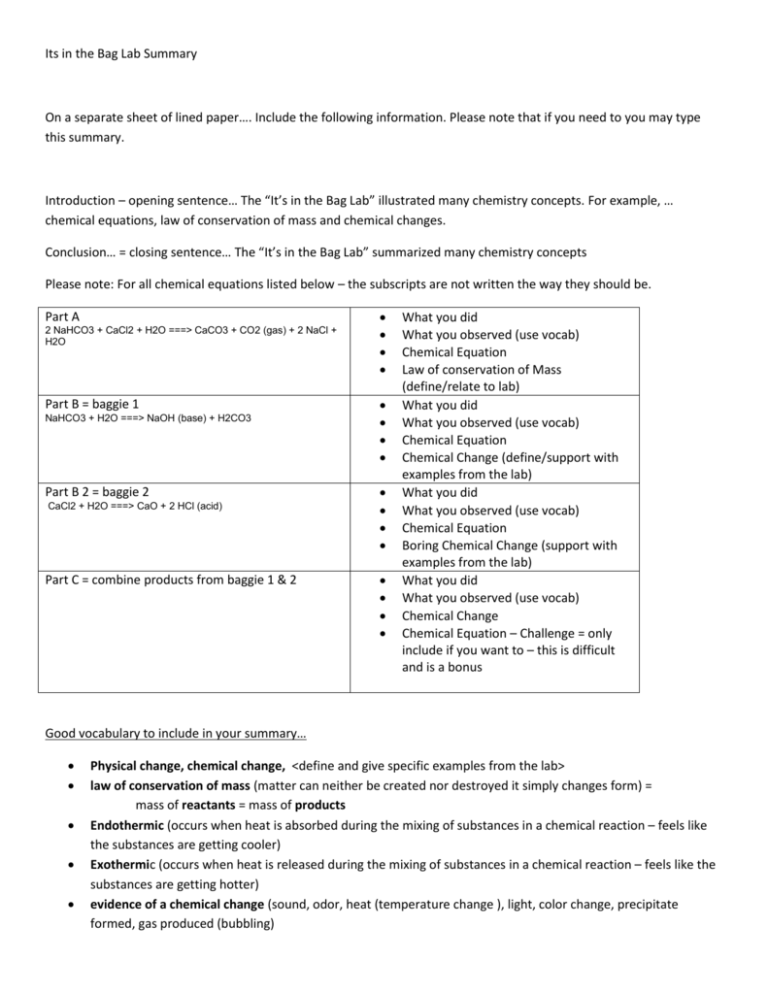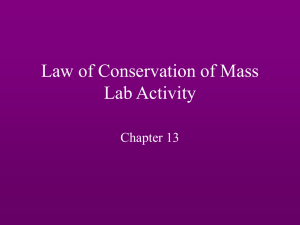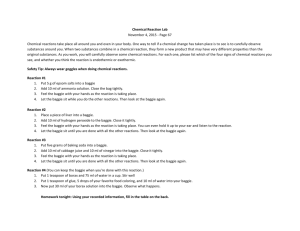Its in the Bag Lab Summary
advertisement

Its in the Bag Lab Summary On a separate sheet of lined paper…. Include the following information. Please note that if you need to you may type this summary. Introduction – opening sentence… The “It’s in the Bag Lab” illustrated many chemistry concepts. For example, … chemical equations, law of conservation of mass and chemical changes. Conclusion… = closing sentence… The “It’s in the Bag Lab” summarized many chemistry concepts Please note: For all chemical equations listed below – the subscripts are not written the way they should be. Part A 2 NaHCO3 + CaCl2 + H2O ===> CaCO3 + CO2 (gas) + 2 NaCl + H2O Part B = baggie 1 NaHCO3 + H2O ===> NaOH (base) + H2CO3 Part B 2 = baggie 2 CaCl2 + H2O ===> CaO + 2 HCl (acid) Part C = combine products from baggie 1 & 2 What you did What you observed (use vocab) Chemical Equation Law of conservation of Mass (define/relate to lab) What you did What you observed (use vocab) Chemical Equation Chemical Change (define/support with examples from the lab) What you did What you observed (use vocab) Chemical Equation Boring Chemical Change (support with examples from the lab) What you did What you observed (use vocab) Chemical Change Chemical Equation – Challenge = only include if you want to – this is difficult and is a bonus Good vocabulary to include in your summary… Physical change, chemical change, <define and give specific examples from the lab> law of conservation of mass (matter can neither be created nor destroyed it simply changes form) = mass of reactants = mass of products Endothermic (occurs when heat is absorbed during the mixing of substances in a chemical reaction – feels like the substances are getting cooler) Exothermic (occurs when heat is released during the mixing of substances in a chemical reaction – feels like the substances are getting hotter) evidence of a chemical change (sound, odor, heat (temperature change ), light, color change, precipitate formed, gas produced (bubbling) Phenol red – indicator = a substance that changes color in the presence of another substance Phenol red = pink = if pH above 8.2 = base Phenol red went from pink yellow if pH below 6.8 = acid Sample Writing Keep it simple – keep it technical (dry, dull boring, scientific writing) The “It’s in the Bag Lab” illustrated many chemistry concepts. For example, … chemical equations, law of conservation of mass and chemical changes. In Part A, I added one scoop of baking soda and one scoop of calcium chloride and 10 mL of water to a ziplock baggie and then mixed the reactants. I observed the following (which indicated that a chemical change occurred) there was the sound of fizzing, a gas was produced (the baggie inflated and got puffy) there was a color change from pink to yellow and there was a temperature change the baggie got (hotter/colder – indicating exothermic reaction/endothermic reaction … you choose what happened in your lab). <You can include the definitions for chemical change here> Part A also illustrated the law of conservation of mass which states that matter can neither be created nor destroyed it simply changes form <the mass of the reactants = the mass of the products>. For example in my lab, the initial mass was ___g and the final mass was ___g. Therefore, my lab supports the law of conservation of mass. <The difference in the initial and final mass is because….> The chemical equation for this part of the lab is 2 NaHCO3 + CaCl2 ===> CaCO3 + CO2 + 2 NaCl + H2O Or…. You can submit your “summary” in the form of two column notes…. Part A = What you did = In Part A, I added one scoop of baking soda and one scoop of calcium chloride and 10 mL of water to a ziplock baggie and then mixed the reactants. What you observed (use vocab) = I observed the following (which indicated that a chemical change occurred) there was the sound of fizzing, a gas was produced (the baggie inflated and got puffy) there was a color change from pink to yellow and there was a temperature change the baggie got (hotter/colder – indicating exothermic reaction/endothermic reaction … you choose what happened in your lab). Chemical Equation = ….> The chemical equation for this part of the lab is 2 NaHCO3 + CaCl2 ===> CaCO3 + CO2 + 2 NaCl + H2O Law of conservation of Mass (define/relate to lab) = Part A also illustrated the law of conservation of mass which states that matter can neither be created nor destroyed it simply changes form <the mass of the reactants = the mass of the products>. For example in my lab, the initial mass was ___g and the final mass was ___g. Therefore, my lab supports the law of conservation of mass. <The difference in the initial and final mass is because….>








